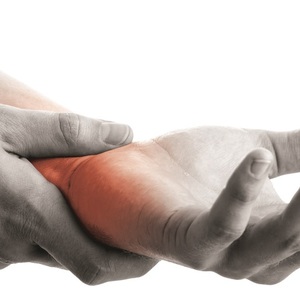
If you stop and think about it, there’s not many activities that do not involve some sort of movement with the wrists. Whether at work, home, or playing sport, our wrists are integral in our daily lives. It’s not surprising then that wrist injuries are very common. They are frequently injured through overuse, repetitive movements, and when a slip or fall occurs; we instinctively put our hands out to save ourselves during a fall, and that can, in turn, lead to a wrist injury.
Wrist injuries can see you sidelined; unable to work or kept off the playing field for weeks at a time. It’s also difficult to go about your everyday life with an injured wrist. Imagine finding it difficult to lift your favourite mug!
Here at Physio Med, we have a team of Chartered Physiotherapists who are able to offer you tailored programmes to banish any pain you have from a wrist injury. We can also give advice on how to prevent any future injuries.
It may not seem it, but the wrist is a pretty complicated structure. Each wrist is comprised of eight separate small bones (the carpal bones), and each of these small bones forms a joint with the bone next to it. The ends of the bones are covered in cartilage, and then there are ligaments connecting all the small bones with each other, and to the larger bones in the arm. Phew! More complicated than you would think by just looking at your wrist! Unfortunately, the more components, the more ways you can injure your wrist.
Common Wrist Injuries
Without a doubt, the most common form of wrist injury is caused when we fall and put our arms out to brace ourselves. The sudden weight against the wrists can cause a good deal of damage. This injury could also occur if you brace yourself against the dashboard or steering wheel during a car accident. Using the wrists to brace yourself is absolutely human nature, but it can cause a number of problems; from breaking the bones of the wrists, to damaging the ligaments. The severity of the injury usually depends on how the wrist was positioned during the incident that caused the injury and how much force was involved. How strong your bones are is also a factor.
Repetitive Strain Injury (RSI) is another very common form of wrist injury. This injury can strike down a wide variety of people; from unsuspecting office workers, to people working on factory lines. RSI is a general term used to describe the pain felt in muscles, nerves and tendons caused by repetitive movement and overuse. That can be something as simple as using your computer non-stop day after day, without the appropriate ergonomic solutions in place. It’s worth being aware that employers have certain responsibilities where RSI is concerned.
Our therapists at Physio Med can offer advice regarding ergonomic work practices which can help prevent Repetitive Strain Injuries, as well as physiotherapy for any existing injury. Symptoms of RSI include: pain or tenderness, stiffness, tingling or numbness, and cramp. RSI can also affect the neck and other parts of the body.
Contact us for a friendly chat regarding any RSI symptoms you may have. We can design a programme of stretching and strengthening exercises that you can perform in the workplace to reduce muscle tension and stiffness.
Prevention of Wrist Injuries (Be S.M.A.R.T)
The Canadian Physiotherapy Association has created the ’S.M.A.R.T’ guidelines for computer use that you and your family can follow at home, at school and at work. The steps are easy to remember: S.M.A.R.T. is an acronym for Stretch, Move, Add it up, Reduce strain and Talk to a physiotherapist. Following these guidelines will go a long way towards preventing wrist problems associated with RSI.
Stretch
Include regular stretching into your work routine. Every 20 to 60 minutes, do three or four stretches – for hands, shoulders, neck and trunk.
Move
Get up from your work station for a short stretch or walk around to promote blood flow to fatigued muscles every hour. Try to get regular daily exercise, away from the computer.
Add It Up
Add variety to your tasks. Vary what you do, such as typing, filing, using the telephone, reading documents, etc.
Reduce Strain
- Make sure you are sitting correctly with your back supported
- Adjust your chair, sit with your buttocks right back in the chair and your feet flat on the floor, or on a footrest
- Your knees should be bent at a 90-degree angle, at the same level or slightly above your hips
- Keep your shoulders relaxed
- Have your arms close to your body or resting comfortably on the armrests, which should be positioned close to your sides; elbows bent at approximately 90 degrees
- Try to keep your wrists straight, which may involve adjusting the angle of the keyboard
- Keep your eyes level within range of the top third of the screen. Don’t squint to see the screen (check for glare or enlarge the font)
- Keep your wrist straight and move the mouse with whole arm movements
- Use ergonomic computer accessories, such as document holders to encourage neutral neck postures, and headsets to avoid awkward neck postures
- A wrist pad on the keyboard allows you to rest your wrists on the pad and reduces stress on the wrist
- If you’re working on a computer all day at work, you may want to limit your computer-time at home
Talk To Us
RSI can be prevented, but if symptoms do occur, early intervention is the best form of treatment. If you are experiencing regular or increasing discomfort while sitting at your computer, take early corrective action. Physio Med will listen to your symptoms and assess you to help provide appropriate treatment, including information about correct posture and positioning at your workstation. We will also work towards an earlier return to your daily lifestyle as well as provide guidance on how to prevent recurrence of injury.
Our Senior Chartered Physiotherapists assist people of all ages and lifestyles, with gaining and maintaining their desired level of active living and physical functioning. With our applied knowledge and understanding of the human body in action, we are able to help you to increase mobility, relieve pain, build strength, and improve balance and cardiovascular function.
We will be happy to talk to you and answer any questions you may have about whether physiotherapy is right for you.
For more information, please feel free to get in touch:
Tel: 0113 229 1300
Website: Contact Us Form



